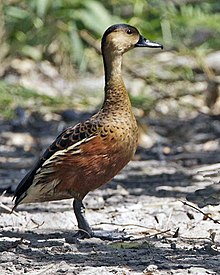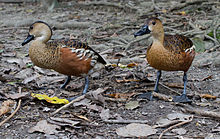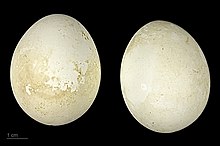Peregrine Whistle Goose
| Peregrine Whistle Goose | ||||||||||||
|---|---|---|---|---|---|---|---|---|---|---|---|---|

Peregrine Whistle Goose ( Dendrocygna arcuata ) |
||||||||||||
| Systematics | ||||||||||||
|
||||||||||||
| Scientific name | ||||||||||||
| Dendrocygna arcuata | ||||||||||||
| ( Horsfield , 1824) |

The piper goose ( Dendrocygna arcuata ) is a species of the duck bird family that occurs in Australasia . Extensive observations on their way of life are only available for the subspecies Australian piper goose ( D. a. Australis ) which is widespread in Australia . The main distribution center of the piper goose is the north of Australia. During the dry season, when the birds gather at the remaining waterways, individual flocks can consist of several thousand individuals.
The IUCN classifies the piper goose as not endangered ( least concern ). The population is estimated at 200,000 to 2 million sexually mature individuals.
Appearance
The piper goose reaches a body length of 55 to 60 centimeters. The wingspan is 80 to 90 centimeters. They weigh an average of 735 grams. The peregrine whistle goose shows only a slight sexual dimorphism . The females are only slightly less intensely colored than the males.
Adult piper geese have a dark brown to black skull and back neck, the sides of the head and the sides of the neck are pale brown to reddish brown. A blurred line of eyes runs through the face. The front breast is reddish brown and looks scaled by the dark feather hems. The back and the rump are dark brown to black, the feathers sometimes have broad, strong chestnut brown edges. The flanks are chestnut brown and have individual elongated lanceolate feathers. The under tail-coverts are white, the belly is chestnut-colored. The iris is red-brown. The beak, legs and feet are black.
Newly hatched chicks are black-gray with a slightly brownish tinge on the upper side of the body. The underside of the body is gray-white. There is a narrow band in the neck that is interrupted at the back of the neck. There is no stain on the back. The bill, iris and legs are dark gray. Young birds are similar to the adult birds, but the sides of the body are washed out red-brown, the breast spots are somewhat coarser and the flank feathers are shorter and do not yet have such a pure, light tone as in the adult birds.
Possible confusion
Whistling geese are not to be confused with any other species due to their upright posture. Their long neck and legs help differentiate them from other species of ducks. In flight they are noticeable by their utterances and the whistling smell of flight. The wandering whistle itself can only be confused with the sickle whistle, which has a distribution area similar to that of the wandering whistle. The sickle whistle goose is generally paler, larger and has a leaner build. This species also has maroon front flanks that are conspicuously striped. Legs and feet of this species are pink to strong flesh-colored and not gray as in the piper goose. Crescent Whistle Geese also have a less water-related lifestyle.
Typical behaviors
Outside of the breeding season, the piper goose is a very sociable species. It can then be observed in flocks that can occasionally consist of several thousand individuals. The troop size increases with the increasing dry season, during the dry season in 1964 troops were observed in the Northern Territory, which consisted of up to 40,000 individuals. These troops are often associated with the sickle whistle goose. They prefer to stay in places with greater water depth and rest on sand and mud banks at the water's edge or in shallow water. Migratory whistle geese are good swimmers and dive frequently. Large troops floating on the water typically move in one direction, while the water whistle geese at the end of the troop keep flying up and sit at the head of the troop to look for food.
The flight pattern of the piper geese corresponds to that of other whistling geese: the head is lower than the back during the flight, the legs hang down. The wing beat is slow. Whistling flight noises and the typical high-pitched whistling that gave the subfamily its name can be heard.
Distribution area
The main distribution center of the piper goose is the north and northeast of Australia. It also occurs in the Philippines and was observed twice in Borneo in 1960. Sulawesi , Java , the Lesser Sunda Islands , New Guinea and New Britain also belong to the distribution area . It was resident in the Fiji Islands until at least 1959 and earlier it also settled New Caledonia .
The migratory movements of the piper goose have not yet been conclusively investigated. It cannot be ruled out that they are migratory birds or that they are dispersing birds that quickly colonize suitable habitats that are newly created during the rainy season. During the dry seasons, pigeon geese often gather in flocks in the remaining waters. With the onset of the rainy season in November and December, these troops dissolve very quickly. They gather again at these permanent bodies of water in the months of April through May.
habitat
With regard to their habitat requirements, the piper goose has a lot in common with the sickle whistle goose . However, it is more strongly bound to the water than this and can be found all year round in large shallow waters, which have a rich flora of swimming and underwater plants. Their habitat are both tropical and subtropical regions, the largest accumulations are found in the floodplains in the coastal region of the Australian Northern Territory.
food
Similar to the sickle whistle goose, the wandering whistle goose has a purely vegetable diet. It eats green parts, seeds and buds of various aquatic and marsh plants in changing proportions every season. In particular, water lilies, wild rice and millet species play a larger role. The food is consumed by diving, grounding and being. The dives reach a depth of up to three meters. The few insects that the piper goose eats are more likely to be accidentally eaten.
Migratory whistle geese often search for food in dense schools. The swarm moves in the same direction. Foraging for food takes place mainly during twilight and at night. During the day, piper geese rest on sandbanks or standing in shallow water.
Reproduction
The reproductive behavior of the piper geese has not yet been conclusively investigated. In any case, they are monogamous birds, the pairing of which may last until one of the two partner birds dies. The couple selects the nesting location together, the brood and the chicks are managed by both parent birds. It has been observed that couples occasionally even adopt orphaned chicks, even sickle whistle geese chicks are adopted by them. The reproductive behavior is triggered by the onset of the rainy season and falls in the Northern Territory in the first half of the year. Newly created nests were observed there in both January and June. During a pronounced dry season in Queensland, piper geese only breed there between January 4th and February 17th and only a small number of pairs raised offspring at all.
The nests of the piper goose are well hidden in the slightly elevated grassland, which is therefore not at risk of flooding. The nest has no downy padding. The breeding season is estimated at 28 to 30 days. Chicks hatched in captivity weighed an average of 20 grams shortly after hatching. They were fully feathered at ten weeks, but only able to fly between 12 and 13 weeks of age.
Systematics
There are three subspecies that differ mainly in their size and less in their color. One of the subspecies that is native to the Fiji Islands and New Britain, the little piper goose ( Dendrocygna arcuata pygmaea ) is considered extremely threatened. The nominate form ( D. a. Arcuata ) is only partially known. At least in parts of its range - some islands in the Philippines and the lowlands of New Guinea - it is still very numerous. The Australian piper goose ( D. a. Australis ) can still be seen frequently, at least in the north of Australia. In contrast, their stocks are falling in eastern Australia.
The exact relationships of the whistling geese are as follows:
| Whistling Geese (Dendrocygninae) |
|
|||||||||||||||||||||||||||||||||||||||||||||
|
|
attitude
According to current knowledge, the world's first breeding was achieved by a private owner in California. Overall, piper geese were rare in zoos and private homes. It was not until the 1980s that large numbers of pigeon geese were imported from Indonesia. With these birds some private owners were bred several times.
Individual references, literature and web links
literature
- T. Bartlett: Ducks And Geese - A Guide To Management. The Crowood Press, 2002, ISBN 1-85223-650-7 .
- PJ Higgins (Ed.): Handbook of Australian, New Zealand & Antarctic Birds. Volume 1: Ratites to Ducks. Oxford University Press, Oxford 1990, ISBN 0195530683 .
- Hartmut Kolbe: The world's ducks. Ulmer Verlag 1999, ISBN 3-8001-7442-1 .
Web links
- Dendrocygna arcuata inthe IUCN Red List of Threatened Species 2013.1. Listed by: BirdLife International, 2012. Retrieved September 8, 2013.




